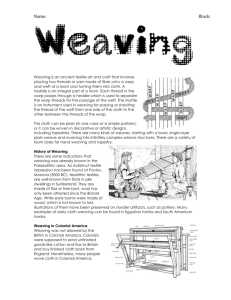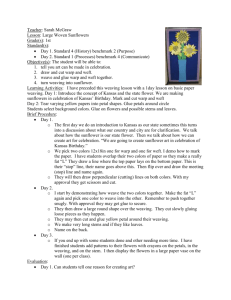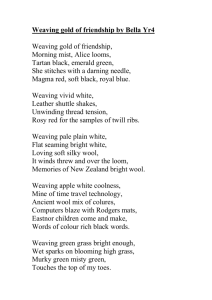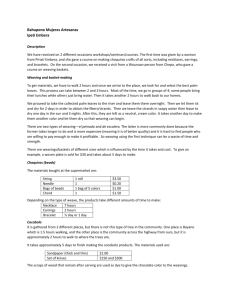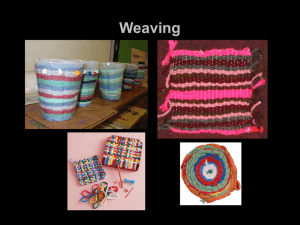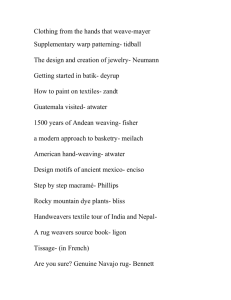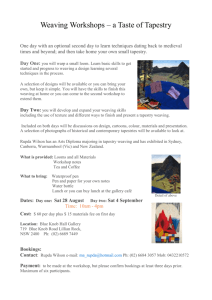Three Dimensional Weaving of Tubular Structures
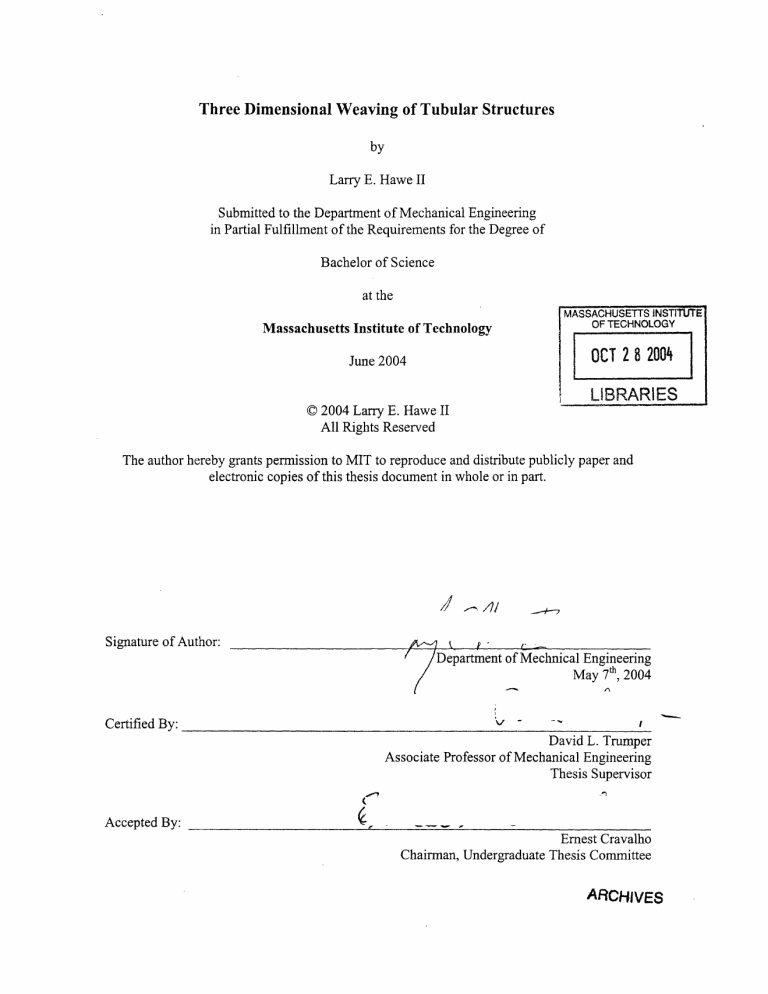
Signature of Author:
Certified By:
Accepted By:
Three Dimensional Weaving of Tubular Structures
by
Larry E. Hawe II
Submitted to the Department of Mechanical Engineering in Partial Fulfillment of the Requirements for the Degree of
Bachelor of Science at the
Massachusetts Institute of Technology
June 2004
MASSACHUSETTS NSTME
OF TECHNOLOGY
OCT 2 8 200
LIBRARIES
_,_
© 2004 Larry E. Hawe II
All Rights Reserved
The author hereby grants permission to MIT to reproduce and distribute publicly paper and electronic copies of this thesis document in whole or in part.
( k
/
//
Department
'41
1 I /I -_ of Mechnical Engineering
__
May
7 n th, 2004
I
V -
David L. Trumper
Associate Professor of Mechanical Engineering
Thesis Supervisor
Ernest Cravalho
Chairman, Undergraduate Thesis Committee
ARCHIVES
Three Dimensional Weaving of Tubular Structures
by
Larry E. Hawe II
Submitted to the Department of Mechanical Engineering on May
7 th,
2004, in Partial Fulfillment of the
Requirements for the Degree of Bachelor of Science in
Mechanical Engineering.
Abstract
Current medical practices for repairing blood vessels include the implantation of artificial stents in place of living tissue. If living tissues could be used instead of synthetic fibers, the body's immune system would not reject the repair. This thesis covers the design and implementation of a weaving machine that is capable of weaving living tissue into three dimensional tubular structures. This prototyped machine is not ready for patient use; however, the machine does prove the feasibility of this weaving technique. This report also includes the design of actuators that would make the prototyped machine completed automated and capable of weaving more complex tubular structures.
Thesis Supervisor: David L. Trumper
Title: Associate Professor of Mechanical Engineering
2
Table of Contents
1. Introduction...........................................................................................................................5
1.1. Purpose............................................................................................................................5
1.2. Project Overview ............................................................................................................
5
1.3. Organization....................................................................................................................5
1.4. A cknow ledgem ents.........................................................................................................6
2. Project Background ..............................................................................................................
7
2.1. Three Dimensional Weaving Uses ..................................................................................
7
2.2. Two Dimensional Weaving Methods .............................................................................
7
2.3. Three Dimensional Weaving Methods ...........................................................................
8
2.4. Individual A ctuation .....................................................................................................
11
3. The Machine ........................................................................................................................
14
3.1. H ettle Block ..................................................................................................................
14
3.2. H ettle Fan Out Block ....................................................................................................
15
3.3. H ettle Actuation Rods ...................................................................................................
17
3.4. The Com b ......................................................................................................................
19
3.5. The Spool ......................................................................................................................
20
3.6. The Clam p .....................................................................................................................
22
3.7. W eaving Procedure .......................................................................................................
22
3.8. Completed Machine and Results ..................................................................................
23
4. Actuation Block Design ......................................................................................................
27
4.1. Spacing Requirem ents ..................................................................................................
27
4.2. Solenoid Physics ...........................................................................................................
27
4.3. Solenoid D esign ............................................................................................................
28
5. Recommendations and Future Work ................................................................................
33
6. Glossary ................................................................................................................................
34
3
Figure 2.1
Figure 2.2
Table of Contents
Method for Weaving a Sheet .......................................................................................
8
Method for Weaving a Three Dimensional Tube ........................................................
9
Figure 2.3
Figure 2.4
Figure 2.5
Figure 3.1
Figure 3.2
Figure 3.3
Figure 3.4
Figure 3.5
Figure 3.6
Figure 3.7
Figure 3.8
Figure 3.9
Figure 3.10
Figure 3.11
Figure 3.12
Figure 4.1
Figure 4.2
Figure 4.3
Figure 4.4
Figure 4.5
Example of Woven Tube Shape ................................................................................
10
Combining Weaving Steps to Eliminate Density Issue ............................................. 11
Different Weaving Orientations with Individual Hettle Actuation ........................... 12
Hettle Bearing Block Assembly Design ....................................................................
14
Hettle Fan Out Block Design ....................................................................................
Hettle Fan Out Block Implementation ......................................................................
The Com b ..................................................................................................................
16
17
Hettle Actuation Rods ...............................................................................................
18
Hettle Actuation Rod Implementation ...............................................
9........................9
20
The Spool Assembly Rear View ...............................................................................
21
The Spool Assembly Front View ..............................................................................
21
The Clam p .................................................................................................................
22
Completed Three Dimensional Weaving Machine Prototype ................................... 24
Completed Prototype Woven Tube ...........................................................................
25
Completed Prototype "T" Junction ............................................................................
26
Solenoid Coil Sandwich ............................................................................................
28
Actuation Block Cutout .............................................................................................
29
Motion View of Actuator ..........................................................................................
30
Actuation Block with 2 Solenoids .............................................................................
31
Complete Mounted Actuation Block .........................................................................
32
4
1. Introduction
1.1. Purpose
This document discusses the design and implementation of a prototyped manual weaving device capable of weaving three dimensional tubular structures. This document contains a brief overview of current weaving methods and a description of redesigning those methods to produce a method for three dimensional weaving. The purpose of this report is two fold: first is to prove that this weaving technology is technically sound and discuss how it is achieved; second is to provide a design for an automated machine for future study and prototyping.
1.2. Project Overview
This thesis began as a group project in Professor Alex Slocum's Precision Machine Design class.
In this class, the group designed a automated weaving machine capable of weaving three dimensional tubes with a very high number of threads per inch with living tissue. A prototype for the actuation of the individual needles (known as hettles) was built using a two to one scale by
Jeff Lieberman, a graduate student in the department of Mechanical Engineering. However, this design was never implemented and no tubular structures were ever woven. The next logical step was to create a prototype weaving machine to test the feasibility of weaving a three dimensional tubular structure and identify problems with the weaving process.
This is what the main bulk of this thesis covers. The first part of the thesis covers the design and implementation of the weaving machine. The machine is broken into its individual parts and the designs and implementations are discussed. The second part of the thesis covers the redesign of the automated actuation block that controls each of the individual hettles. The design has been changed completely from that achieved in the Precision Machine Design project. The next step is to build this actuation block and integrate it into the current prototype.
1.3. Organization
This report covers the design of the prototype weaving machine and its operation, as well as the design for an automated actuation block. Section 2 provides the background information necessary to understand the weaving process. This includes current weaving methods in industry and several methods for weaving in three dimensions. It also discusses the need for weaving in three dimensions. This section is necessary to understand the design of the weaving prototype.
Section 3 describes the design and implementation of the actual machine. Methods of operation are included in this section. Section 4 describes the design of an actuation block and integration into the current prototype. Section 5 covers recommendations for future work. Section 6 is a short glossary of weaving terms used in this thesis.
5
1.4. Acknowledgements
I would like to thank everyone who helped me on this project. Special thanks to Dr. Jennifer
White of MGH for bringing this problem to MIT and suggesting it as a thesis topic, and for her weeks of searching for a source of Polyglycolic Acid. To Charlie Howland for allowing a tour of his weaving facility, assistance with the weaving technology in industry and provision of key weaving parts of the machine. Special thanks to Steve Haberek for his machining expertise and valuable design suggestions, Bob Nuttal for water jetting the bearing blocks and all the machinists in the Pappalardo Laboratory for their assistance. To my roommates for living with all the Dremeling and drilling I did at my desk. To Darlene Utter for proofreading and offering constructive criticisms to my writing style. Finally, to Professor David Trumper for his assistance, guidance and motivation, which without this thesis would not exist.
6
2. Project Background
In order to understand the weaving machine prototype, it is first necessary to analyze the methods for weaving in three dimensions. This section first goes over why one would choose to weave in three dimensions. It then discusses weaving in two dimensions and several methods of weaving in three dimensions. This section also discusses the parts involved in weaving and their terminology, which will be used extensively in this report.
2.1. Three Dimensional Weaving Uses
Before beginning to describe the three dimensional weaving process, it is prudent to discuss why anyone would want to weave in three dimensions in the first place. The original problem that
Doctor White brought to MIT was that of creating a stent (an artificial tubular structure) out of a living tissue called Small Intestine Submucosa (SIS) as the weft material and Polyglycolic Acid
(PGA) as the warp. PGA is an absorbable suture material used in cardiac surgeries. This tube could be used as an artificial blood vessel. If such a tube could be made, the advantages would be enormous. SIS has a unique property that when implanted into an animal, it is not recognized as foreign or "non-self' but in fact is accepted as part of host. More remarkably, the animals own immune system can build onto this SIS tube and eventually the SIS is absorbed into the body leaving a tube that cannot be distinguished from the tissue around it. A fully formed vessel is left in its place.
Unfortunately, to date SIS is only available in sheet form and therefore cannot be knit like most artificial blood vessels are made today. A new method of creating this tube out of SIS was needed. Given that SIS is only available in sheet form, weaving a tube using SIS as the fill material was the best option. Thus, this project will use small strips of an SIS like material as the fill for a woven tubular structure.
2.2. Two Dimensional Weaving Methods
Now that a method for creating the tubular structure has been established, the actual weaving process must be considered. Before considering weaving a tube in three dimensions, it is necessary to look at how weaving is accomplished in two dimensions, such as weaving a sheet.
This weaving process is illustrated in Figure 2.1.
7
Figure 2.1 Method for Weaving a Sheet
Figure 2.1 depicts how the weaving of a sheet of material is accomplished. Each of the black dots represents one thread, coming out of the sheet. The material in this orientation is said to be in the "machine direction" and known as the warp. The top part of the picture shows the first step of the weaving. Every other warp thread is lifted up and a piece of material, known as the fill or the weft, is placed in between the lifted and stationary warp threads. When the lifted warp threads are returned to their stationary positions, the weave looks much like the top image in
Figure 2.1. The second part of the image shows the exact same step, except those warp threads that we not lifted last time are lifted this time. This continues, alternating which warp threads are lifted and the end result is the sheet seen on the bottom part of Figure 2.1.
2.3. Three Dimensional Weaving Methods
Weaving in three dimensions is slightly more difficult. To weave a tube, the approach is to weave two sheets of material simultaneously on top of each other and weave those sheets together at their edges. This process is illustrated in Figure 2.2.
8
*
R
* * 0 0
* *
·
0
-~
* 0
·
0
* 0
e
*
0 0
·
0
·
0
·
0
-~~~~~
0 0 0 0~~~~~~~~~~~~~~~~~~~~~~~~~~~~~~~0
Figure 2.2 Method for Weaving a Three Dimensional Tube
9
Figure 2.2 shows the complexity of weaving in 3 dimensions. There is the same number of warp threads in Figure 2.2 just as in Figure 2.1. However, the threads in the center have been slightly raised or lowered for clarity. The top part of Figure 2.2 shows the first step in the weaving process. Both the left and right sides are woven exactly like the sheet in Figure 2.1, but the center of the weave is different. Instead of alternating between every other warp thread, the weft threads alternate between every fourth thread. This method is exactly like alternating every other thread for the two sheets, one on top and one on bottom. The three images in the center of Figure 2.2
show the incremental steps of this weaving method. The bottom part of Figure 2.2 shows a final picture after combining each of the four steps. A tube is formed between the two sheets in the middle. This tube looks similar to Figure 2.3. The two sheets on either side of the tube are known as the "tapes".
Figure 2.3 Example of Woven Tube Shape
There are several caveats to this procedure. First, notice that the density of the sheets in the middle is half that of the sheets on either side of the formed tube. Therefore, the machine must have twice as many warp threads as are required in the tube walls. This density issue is also present in the weft. The weft threads fill in the tapes but alternate between the upper wall and the lower wall of the tube. Therefore the weft material must be sufficiently fine to accommodate this density problem. Fortunately, there is a way around this problem. This method was overlooked in the original design of the weaving machine as part of the Precision Machine Design project.
Instead of weaving each weft strip individually, it is possible to combine the first two stages in
Figure 2.2 together and weave two tapes directly on top of each other. This is illustrated in
Figure 2.4.
10
0
0
0~~
Figure 2.4 Combining Weaving Steps to Eliminate Density Issue
This method is can only be used when the weft is in strip form and cannot be used when using a thread as a weft material. Therefore, the total thread density of the tube walls will be approximately one quarter that of the density of the tapes on the sides of the tube when using a thread as the weft. When using a strip like material, the density of the tube walls is one half that of the tapes formed on the edges of the tube.
2.4. Individual Actuation
The three dimensional weaving technique calls for the use of 6 individual hettle frames. That is to say, each hettle can be actuated correctly when there are a minimum of 6 different groups of hettles. For example, the above tubular structure can be made with one frame controlling every odd thread in each of the tapes (along the sides where there is no tube formation), one controlling every even thread in the tapes, one controlling the even threads in each of the tube walls (top and bottom) and one controlling the odd threads in each of the tube walls (top and bottom) for a grand total of 6 frames. Therefore the question is, why actuate all of the hettles individually if a tube can be created with 6 frames? The answer is evident upon inspection of Figure 2.5.
11
Figure 2.5 Different Weaving Orientations with Individual Hettle Actuation
It is possible to weave a tubular structures in two different orientations even when the machine is limited to 6 frames. For example, the tube to the far right of Figure 2.5 is the basic constant diameter tube that can be woven with exactly 6 frames. The warp threads are running up and down the page and the weft is inserted from left to right. The tube on the top of Figure 2.5 can be woven with only 4 hettle frames. However, the T-shaped tube is requires a total of 8 hettle frames to weave. The tube woven at an angle might require 30 different hettle frames depending on its angle and length. This is not practical, and therefore individual actuation is required to make this tube. This tube is important because the material is not at 90 degree angles with the tube. The mechanics of the finished tube will be different from those made at 90 degree angles.
With woven fabrics, different biomechanical behavior is observed based on warp and weft direction. Elasticity is greatest at approximately a 45 degree angle and very desirable in an
12
artificial blood vessel. Furthermore, tube diameter cannot be changed unless the hettle frames are reset. Resetting the hettle frames might take several hours. Individual actuation allows constantly variable tube diameter and orientation. Therefore a prototype weaving machine with individual actuation is preferable.
With that said, this machine will have only 6 hettle "frames". This machine is manual, so individual actuation is impractical and thus complex tubular structures are not possible. When the design for the actuation block is integrated into this prototype, complex tubular shapes will be possible as the machine will be fully individually actuated.
For this project, the machine will weave a three dimensional tube with an overall pitch of 20 threads per inch in the machine direction. Therefore, the tube walls have a density of 10 threads per inch. This project also uses a strip like material as the weft, and therefore I used the method of Figure 2.4 to eliminate the density issue. The tubular structures are made with Rayon as the warp and Tyvek as the weft. Rayon was chosen as an approximation to PGA and Tyvek chosen as an approximation to SIS.
13
3. The Machine
The prototype machine is a completely manual weaving machine. This greatly reduces its complexity; however, there are several components of the machine that required precision machining on small scales. All the components of the machine are listed in this section, followed by an explanation of the weaving steps as a description of the final product.
3.1. Hettle Block
The needles that lift up each of the individual warp threads are known as hettles. This machine has a pitch of 20 threads per inch and a working width of 3 inches, and thus there are 60 individual hettles. Each of these hettles must be able to lift approximately 1.25 inches. Therefore, they require bearing blocks to maintain their alignments and provide a support structure. These blocks are pictured in Figure 3.1.
Figure 3.1 Hettle Bearing Block Assembly Design
14
These blocks are made from a sheet quarter inch sheet of Polyvinyl Chloride (PVC). For clarity, only two of the hettles are shown. The slots in the blocks were water jetted and clean out with a dremel tool. The blocks are more than adequate for a manual machine under slow speeds, but a new method of manufacturing them should be found for higher speed and better bearing surface finish. There are two different rows of hettles spaced about one quarter inch apart. At 20 hettles per inch, there is insufficient material in between the hettles, and thus the slots needed to be spread out.
3.2. Hettle Fan Out Block
The hettle bearing block assembly provides a base for the hettles, the hettle pitch is two fine to allow for electromechanical actuation. It is necessary to "fan out" the hettles to the actuation block for a practical machine. This is accomplished by the Hettle Fan Out Block shown in Figure
3.2.
15
Figure 3.2 Hettle Fan Out Block Design
Directly above the hettles is another PVC block machined with the same pattern as each of the hettle bearing blocks, except with holes instead of slots. Above this block is yet another PVC block with holes spaced out at quarter inch intervals. A piece of heavy duty string (such as high test fishing line)) is attached to each of the hettles, run through the hole above the hettle and fanned out to the appropriate hole above. At low speeds, the friction from these holes is negligible, but eventually the line will wear and must be replaced. Now each of the hettles can be actuated individually at a quarter inch spacing, allowing room for electromechanical actuation.
Figure 3.3 shows the actual block to illustrate the fishing line fan out.
16
Figure 3.3 Hettle Fan Out Block Implementation
3.3. Hettle Actuation Rods
As stated before, this the weaving process is accomplished with no automation with this machine. To actuate the threads, 6 hettle "rods" are used. These rods act like the frames discussed in Section 2.4. These rods are pictured in Figure 3.4.
17
Figure 3.4 Hettle Actuation Rods
Depending on the pattern to be woven, each string attached to a hettle is strung through one of the holes on a single rod. The string is attached to the rod by means of a spring clip. Thus each rod acts like a frame, controlling between 1 and 30 hettles. The rods are pictured in their lowered position. When a rod is raised, it is placed in its hold 1 inch above its resting place. This in turn causes the hettles attached to that particular rod to lift, and the corresponding warp threads lift so that the weft strip can be woven into place. This is the final part of the hettle actuation. Figures
3.3 and 3.5 illustrate the completed hettle actuation rod assembly.
18
Figure 3.5 Hettle Actuation Rod Implementation
3.4. The Comb
The comb is the part of the machine that packs the weft into the warp threads. The warp threads are threaded into the comb before the weaving starts. After placing the weft strip into the warp threads, the strip is pushed into place by the comb. The comb can be seen in Figure 3.6
19
Figure 3.6 The Comb
3.5. The Spool
The spool contains the unused warp threads. After the weaving operation is completed, the completed tube is wound off the spool and unused threads take its place. Tension is also controlled by the spool. In front of the spool is a piece of PVC with 2 strips of holes spaced at 10 threads per inch. This piece is designed to give the machine the right thread pitch directly off of the spool. Because this is a manual operation, the spool was would by hand by first threading the warp threads through the entire weaving machine and winding the spool back while keeping tension on the warp threads. This ensures that the each of the warp threads maintains the same tension throughout the weaving process. The spool assembly is shown in Figures 3.7 and 3.8.
20
Figure 3.7 The Spool Assembly Rear View
Figure 3.8 The Spool Assembly Front View
21
3.6. The Clamp
The Clamp is the last part of the weaving machine. The clamp, seen in Figure 3.9, simply clamps the warp threads down and holds them in place during the weaving procedure. Essentially, the clamp is simply a wood block with two pieces of semi-soft rubber as the clamping interface. The clamp is only loosened after the weaving operation is complete. In an automated machine, this clamp should be spring tensioned or on a ball screw to advance the weave and maintain proper tension on the warp threads. This is not necessary in the manual weaving operation.
Figure 3.9 The Clamp
3.7. Weaving Procedure
The weaving of the tubular structure was completed following the method of Figure 2.4. The first step was to lift two of the hettle actuation rods. One of these rods controlled every other thread of each of the two tapes on either side of the tube, and the other rod controlled every other thread of the top sheet to be woven. The weft material was inserted into the weave and pushed closer to the weaving point but not packed with the comb. Two more hettle actuation rods were then lifted. One of these rods controlled the other half of the warp threads in the upper sheet, and
22
Figure 3.10 Completed Three Dimensional Weaving Machine Prototype
Tyvek cut into strips is used as the fill material. Tyvek is commonly used in mailing envelopes.
Its physical properties (thickness, flexibility, overall feel) closely resemble that of SIS while being substantially cheaper to use.
Looking at Figure 3.9, there are a few things that we not mentioned. The strings attached to each of the hettle actuation rods are used to lift up the individual rods. The comb is shown resting on
24
one controlled half the threads in the lower sheet. Another weft strip was inserted and placed directly underneath the previously inserted weft strip. These two strips are then pushed into the weaving interface with the comb and packed tight. This process repeats, alternating the hettle actuation rods to produce the correct pattern. A tube three inches in length takes about 4 to 6 hours to weave.
3.8. Completed Machine and Results
The completed machine is seen in Figure 3.9. This machine has all of the parts mentioned in
Sections 3.1 through 3.8 and is ready to begin a weaving operation. The warp is Rayon, approximating the PGA. PGA was not used in this particular setup because of its prohibitive cost.
23
the clamp on the left of the Figure 3.10. This comb is normally next to the hettles and rests on the second PVC block of the hettle bearing blocks. It stays here until a piece of Tyvek is thread into the warp threads and is used to push the Tyvek into the completed weave. This promotes a dense uniform weave. The spool is locked while the weaving process is underway. If at any time the warp threads start to lose tension, the spool is tightened slightly.
The actual Weaving process took approximately five hours to complete a tube just less than 1 inch in diameter with Tyvek strips ranging in thickness from two mm to five mm. The bulk of this time was spent making sure that the proper needles were being actuated. The fishing line attached to the hettles would sometimes catch on the neighboring hettle and cause an error in the pattern. After the tube was completed, it was necessary to seal the sides and edges of the tube with super glue. Normally the operation would be completed by either cauterizing the edges or by using a locking weave known as a leno weave. The final tube is shown in Figure 3.11.
0191,
/\ AL X.N%\ A
% x, . ,% , .
Figure 3.11 Completed Prototype Woven Tube
This completed tubular structure was completed using the weaving of Figure 2.4 to eliminate the density issue of the Tyvek strips. The Tyvek strips are wider in the middle of the weave and narrower at the ends. This was to explore the optimum thickness of the Tyvek strips. This showed that the thinner the strips were, the more flexible the tube and the higher quality the weave. Each edge of the tube is sealed with super glue to prevent fraying.
25
After this first tube was completed, another prototype tube was woven. This tube was a "T" shaped tube, requiring the use of eight hettle frames. However, because the machine has only six hettle rods, it was necessary to change which hettles were pulled up by each hettle actuation rod half way through the weaving process. In a completely automated design with the proper actuation block, this step would be unnecessary and even more complex tubular structures could be completed. The first prototype woven tube was comprised of strips ranging from two to five mm. Strip width on this tubular structure was kept constant at two mm. This produced a tighter and more uniform weave. The sides and ends of the weave were again sealed with super glue.
This prototype 'T" junction is shown in Figure 3.12.
11 .
, X -. ' sr h,
,. , ,
Z., -x
S,,
:N., N.
\
N
." " as
~
>4 i *
NS
'X-
1-rai
Figure 3.12 Completed Prototype "T" Junction
26
4. Actuation Block Design
As stated in Section 2.4, a weaving machine capable of individually actuating hettles allows for much greater flexibility in deciding tube shape size, orientation and complexity. A machine that individually actuates each of the hettles would be capable of making a tube of constantly varying diameter, a tube which splits off into several other tubes as well as tubes woven at any angle to the warp threads. This section goes over the design of an actuation block that will make this prototype capable of weaving all the structures mentioned above and more.
4.1. Spacing Requirements
There are several commercial off-the-shelf solutions for actuating the hettles individually. For example, one may choose to use small cylindrical solenoids to actuate the individual hettles.
Unfortunately, solenoids that are small enough to be packed together at four threads per inch have throws ranging from a quarter inch to a half inch. This machine requires actuation of at least an inch to eventually allow room for a rapier, which is the automated mechanism for pulling the fill into the weave. Solenoids that have an inch throw are too big to pack into the small area required. It was therefore necessary to go back the basic physics of solenoids and design them such that they had actuation of at least and inch and could be spaced one quarter inch apart.
4.2. Solenoid Physics
The physics of a solenoid are straightforward. In its most elementary level, a solenoid is simply a coil of current carrying wires and a magnet. When this coil is carrying current through a magnetic field, a force is exerted upon it equals:
F- IlxB (1)
Equation (1) simply states that the force on a current carrying wire is equal to the current multiplied by the length of the wire in the magnetic field crossed with the magnetic field where F is the force in Newtons, I is the current in Amperes, 1 is the length of wire in the magnetic field in meters and B is the strength of the magnetic field in Teslas.. Therefore for maximum force in the solenoid, the design should be that the current in the coil is always perpendicular with the magnetic field. Other than that, the highest forces are obtained with bigger coils (increasing 1) and bigger currents (increasing I). B is fixed and dependent on the magnets used in the solenoid.
The force required to lift the hettles varies depending on the tension of the warp threads, but never exceeds 4.5 Newtons.
27
4.3. Solenoid Design
The original template for the solenoid design was created as part of Precision Machine Design by
Jeff Lieberman. This design is a modified version of his original design.
As stated before, the optimal design will have the coil always perpendicular to the magnetic field, and both the magnetic field and the coil perpendicular to the direction of the required force.
The solenoids must also be relatively thin, so the design starts with a sandwich of plastic with a coil in the center as shown in Figure 4.1.
Figure 4.1 Solenoid Coil Sandwich
The solenoid pivots around the hold at the bottom of Figure 4.1. In between the two layers of hard thin plastic rests a coil consisting of between 75 and 150 turns of wire. This coil is made as tall as possible to maximize the length of the wire interacting with the magnetic field per the equation in Section 4.2. This coil sandwich is approximately 5 centimeters tall. In order for the machine to receive a full inch of actuation, the magnets controlling the solenoid must be able to interact with the coil for a swing of 15 degrees in either direction. The magnets only need to interact with the parts of the coil positioned vertically. The solenoid is placed in a series of magnets as shown in Figure 4.2.
28
Figure 4.2 Actuation Block Cutout
Two of the components of Figure 4.2 have been hidden to show the detail of the actuation with respect to the magnets. The next coil sandwich and the spacing block containing the magnets have been hidden, but the magnets have been left in the picture to visualize how many magnets each actuator "feels." The magnets are the chamfered rectangles in the middle of Figure 4.2. The ones on the right of Figure 4.2 interact with one side of the coil and the ones on the left interact with the other. F igure 4.3 shows a motion view of the actuator moving from one extreme to the other. The coil in the coil sandwich and the magnets are all visible.
29
Figure 4.3 Motion View of Actuator
This part of the design was the most crucial. Several different constraints have to be met to make the solenoid effective. First, the parts of the coil that are vertical must always interact with one of the magnets. Furthermore, the horizontal part of the coils must not interact with either of the magnets, as this would cause forces in the vertical directions and cause unnecessary loading of the actuation block.
Theoretically, this solenoid could be used with one magnet. By using two magnets, the solenoid utilizes both sides of the coil. The direction of the current will be opposite for the opposite sides of the coil. Therefore, if one set of magnets is aligned north into the page and the other is aligned north out of the page, the direction of the force is the same on both sides of the coil, and the effective force is doubled relative to using only one magnet.
The actuation blocks are spaced by the metal spacing washers at the corners of the blocks (Figure
4.2). This gives the solenoid a constant spacing and a good bearing surface for the coil sandwich.
The rings below the magnets are rubber o rings used as a stop for the coil sandwich. The "o" ring cushions the coil sandwich when it is in the extreme positions. The hole at the top of the coil sandwich is the place to attach the line connected to the hettle below.
30
The last part of the design is the dowel pin press fitted into each of the coil sandwiches. This dowel pin is connected to the coil sandwich and sits in two brass bearings on either side of the sandwich. The pivot is done this way to avoid big misalignment errors. With two bearings on either side of the coil sandwich, errors due to misalignment are much lower than if the pin was secured to the actuation block and only one bearing was press fitted into the coil sandwich.
Figure 4.2 shows that there are two different pivot positions for the coil sandwich. This is to accommodate the press fit bearings in each of the plates containing the magnets. If only one pivot position was used, the dowel pin would have to be substantially shorter to avoid interfering with the next actuator, and thus more prone to alignment errors. Figure 4.4 shows part of the actuation block with the parts of Figure 4.2 unhidden. Figure 4.5 shows the completed actuation block mounted on top of the machine.
Figure 4.4 Actuation Block with Two Solenoids
31
Figure 4.5 Complete Mounted Actuation Block
Figure 4.5 Shows the completed actuation block mounted on the Fan Out Block of the prototype machine. The solenoids are mounted horizontally so that they naturally rest in the "down" position. After each of the hettles is attached to the actuation block, the hettles become completely automated and can be controlled via a computer interface or from an FPGA.
32
5. Recommendations and Future Work
While this prototype machine works well for manual weaving of a tubular structure, several improvements can be made to the apparatus and to the design.
First, machining the hettle bearing blocks on a water jet cutter was not the optimum technique.
The water jet took off chunks from underneath the PVC while cutting. Furthermore, the jet did not have enough of a tool path to execute proper lead ins and lead outs on the slots, so they were narrower in the middle than at the ends. There are two ways around this problem. The first is to use a different material such as delrin to make machining easier. The second is to change the machining method. It may be possible to wire EDM (Electrical Discharge Machining) a smaller bearing block. However, a bigger slot in the hettle bearing block can be desirable. A bigger slot it allows the hettles to float slightly. In industry, the hettles in frames are not constrained horizontally. The final pitch is set by the comb, not by the hettles. Thus, some lateral freedom in the hettles decreases friction in the machine and does not adversely affect performance.
The biggest problem during weaving was the fishing line knots on top of the hettles. Every now and again, these knots would catch on the neighboring hettles and lift both hettles, causing an error in the weaving. There are a couple of ways to fix this problem. First would be to use a multifilament string like a strong piece of floss or very strong thread with the same tensile strength but much less stiff. This would make it nearly impossible for the knots to interact with neighboring hettles. Another way to fix the problem is to cover each of the knots with a piece of electrical tape to prevent hettles interaction.
The prototype design would benefit from three changes. First, the clamp should not be fixed in one position. A stationary clamp limits the length of the finished tube, and prevents the clamp from controlling the tension of the warp threads. Second, the spool should be moved farther back to accommodate the lifting of the warp threads. The closer the spool is to the hettles, the higher tension is put on the warp threads. The Spool should also be driven by possibly a worm gear system to control tension and to allow for longer tubular structures.
Finally, the complete actuator block should be built and installed into the prototype weaving machine. With the addition of this block, weaving times will be drastically reduced, errors would be reduced and the machine could weave some interesting tubular structures. With an actuation block in place, weaving a tube of between seven and ten centimeters should take no longer than an hour, compared to the four to six hour times to complete similar tubes with the current machine. Eventually, this new prototype could eventually weave a small tube made of SIS and
PGA. This tube would still be much less dense than original machine could weave, but the bio mechanics of the tube could still be tested.
33
6. Glossary
Comb
Part of weaving machine that pushes the weft into the completed weave. The comb is responsible for creating the correct spacing of the weft threads.
EDM
Hettle
Electrical Discharge Machining. Machining technique where a piece of electrified brass wire cuts through difficult to machine materials.
Part of weaving machine that physically lifts each of the warp threads. The hettle looks like a flattened, extended needle. Hettles in industry are made of spring steel.
Machine Direction
The direction that is parallel to the warp threads and perpendicular to the weft threads.
PGA
Polyglycolic Acid. This is an absorbable suture material surgeons use to stitch blood vessels together.
Rapier
Mechanism in automated weaving machine that pulls weft material into the weave.
SIS
Small Intestine Submucosa. This is a tissue engineered substance with growth factors.
When implanted in animals, it is not rejected and eventually is absorbed into the body, leaving tissue that is indistinguishable from the hosts.
Weft
The weaving direction that is perpendicular to the warp fibers. The weft is the material that is inserted into the weave and pushed into place by the comb.
Warp
The threads that are actuated up and down during the weaving process are known collectively as the warp. The warp threads are said to be in the machine direction.
34

